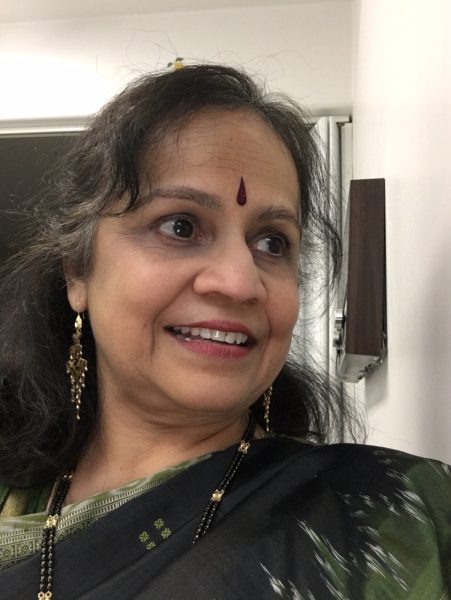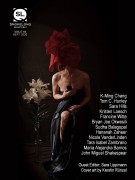There can be something ominous about birds in literature and film: crows, Hitchcockian sea gulls, Poe’s raven. I love bird references in flash because of the visuals, but also the intrinsic flight, hanging over humans, inquisitive eyes, idioms. You skillfully play with bird images in many ways: surreal and imagined, out-of-place and natural. From “there’s a bird in the library” to her “nest of brown hair” to backpack bird, family of myna birds, “quail” title and topknot; we get an entire menagerie. How did you decide what bird elements to include? What is their significance in this flash?
A few years ago, while waiting for a flight scheduled to depart at four a.m., I saw a bird inside the airport terminal in Hyderabad, India. I watched the tiny bird flit from rafter to rafter in the high-ceilinged terminal. Everything about the situation was strange: the hour too early for bird or human, the crowded building an unlikely place for a nest, the noisy travelers, the bright lights, the machines, the luggage, not to mention the giant plane, this huge mechanical bird in the sky, which would soon fly me all the way to the U.S. The image stayed with me and I planted the bird into a library for my story.
Each spring we see mama quails in our neighborhood―these birds do have interesting topknots―their retinue of freshly hatched babies following. Occasionally, one little baby cannot keep up and gets left behind. I imagine the bird in my story is one such lost baby that somehow ends up inside the library.
The tiny quail in the library is displaced, and so is the character in the story, who’s lost in the library, lost in her coursework, lost in a new country; thus, an attachment is formed.
Once the alliance is formed, as if the character and the bird enter into a pact, the bird references naturally knit themselves into the story.
Following in the bird theme, this flash takes the iconic man v. nature to a different level. The tension between characters, cultures, birds, and environment is seamlessly done. How did you decide what tension and conflict would be present?
The tension in the story comes from the angst of displacement.
Everyone remembers their first day of kindergarten. To this day I remember the excitement, but I also remember the gnawing in the pit of my stomach because I was away from the comfort of my home and my mother, with an unknown teacher I must now obey.
Conceive of a similar situation as an adult and magnify the sensation.
Imagine traveling to another country for school, where the library works differently, where the English they speak doesn’t sound like the language you’re used to, where the educational system is unfamiliar, where your funds are limited. On top of this, the cultural pressure, your mother setting you up with an “eligible” young man. Add to this rich amalgam the quail in the library, lost like you, that chooses to jump into your backpack.
It’s all of this that created the fodder for tension.
I’ve read some of your other flashes and found personal ties to your life and culture. I could see this story as a response to a childhood library experience. What connection did you have to this flash? Where did you find inspiration in your own experiences?
I’ll address the last question first. I came to this country, as a student, four decades ago. I wanted to capture that time period: how we did our research in the library, how we turned in typed papers, how the television shows were different, how we listened to music employing devices that are no longer used. That’s where the inspiration came from. However, the specific incidents in the story are completely fictional: the bird, the librarian, the professor, the man on the phone.
Libraries have always been a part of my life. Some libraries in India were run as small businesses, meaning we paid to borrow books. Books at these libraries used to be organized in a haphazard manner, or I should say arranged in a manner only the owner understood. Quite magical how I’d accidentally land upon a treasure of a book. I refer to one such library in the story.
Of course, my school had a more formal library, as did my college―a large, silent, less-casual place.
If you could meet any character (animal, human, or bird) in a library book, who/what would it be? What are your favorite literature examples showcasing birds? What contemporary flash writers inspire and challenge you?
Oh, I would love to meet Atticus Finch from Harper Lee’s To Kill a Mockingbird. Note his last name! To Kill a Mockingbird, one of my favorite books, contains many bird references. The “mockingbird” in the title carries the symbolism that’s so important: It’s not right to kill or hurt something that is innocent and harmless.
There’s such tremendous talent in the flash world, it would be impossible to name just a few writers. Off the top of my head, I’m including flash fiction and creative non-fiction writers: Meg Pokrass, Kathy Fish, K.B. Carle, Tara Isabel Zambrano, Cathy Ulrich, Michelle Ross, Kim Magowan, Sara Siddiqui Chansarkar, and Jacqueline Doyle. I haven’t included writers in other continents—really, there are so many fantastic writers.
What project(s) are you currently working on? Where will we see your work next? Anything else to add?
I have some pieces scheduled for publication this fall and later—Fictive Dream, Brilliant Flash Fiction, The Dribble Drabble Review, and The Sunlight Press. I am also writing a novella-in-flash, something I have not attempted before.
I am beyond honored to have a story published at SmokeLong, a publication I have long admired. So grateful to have my story rubbing shoulders with fiction I consider the best of the best. Many, many thanks to Sara Lippmann for her editing suggestions.



 A SmokeLong Summer 24!
A SmokeLong Summer 24!